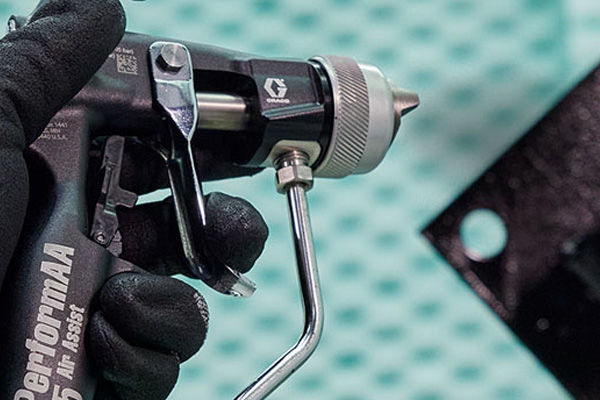Crack the Ergonomics Code
Poor spray gun ergonomics could affect your bottom line in many ways.
The Importance of Spray Gun Ergonomics
Industrial finishing experts agree that atomization and transfer efficiency are important spray gun features. Yet, as it becomes more difficult for manufacturers to find and keep skilled painters, the importance of operator comfort cannot be undersold.
Many painters suffer costly muscle strain or stiffness and repetitive-motion injuries that could be prevented with proper gun ergonomics. For example, annual workers compensation claims for injuries like carpal tunnel syndrome can easily cost more than $30,000.
Poor gun ergonomics not only cost companies money in claims, but also compromise performance and quality. To remedy this, paint line managers are taking steps to make sure operators can comfortably use their most important tool: their paint spray gun.
How to Focus on Operator Comfort
When searching for your next manual spray gun, put yourself in your painter’s shoes. Better yet, involve your paint booth team or paint line operators in spray gun selection.

Ergonomic, lightweight guns with an easy trigger pull often come up as popular choices. In other words, spray guns that fit such criteria help painters perform well for a long time without injury.
To ensure good ergonomics and safety, Graco engineers consulted painters while designing PerformAA air assist spray guns. That’s why the manual spray guns have these features:
- an ultra-light trigger pull that helps reduce fatigue and muscle stress
- a low profile swivel the moves the hose with the operator, preventing tripping and injury
- an handle that fits comfortably in any sized hand
- a finger rest that allows the operator to balance the gun while spraying
PerformAA is just one example of a conventional paint spray gun designed with operator comfort in mind. There are many – conventional and electrostatic – options to choose from.
Try Before You Buy
To make sure you’re selecting the right spray gun for your painters, ask your finishing equipment distributor for product demonstrations. Bring in a variety of applicators for your paint booth team to try.
Whenever possible, demo each spray gun for an entire shift, if not more. Watch how each painter holds the gun, switches hands, even flips the gun to get at different angles.
After each painter gets used to the gun, evaluate finish quality, asking questions like “Do you think this spray gun helped you do your job well or better?”
Finding out – and purchasing – their preference can positively affect your bottom line in many ways. A more comfortable work environment not only prevents injury (and costly claims), it can lead to better productivity and job satisfaction.
References: Bureau of Labor Statistics, U.S. Department of Labor, Occupational Outlook Handbook, Painting and Coating Workers; Occupational Safety and Health Administration (OSHA), U.S. Department of Labor, CHEMICALS AND OTHER HAZARDS IN PAINTING; OSHA, U.S. Department of Labor, Ergonomics: The Study of Work
Did you know?
One instance of carpal tunnel syndrome can easily cost an employer more than $30,000 per year. That's according to the Occupational Health and Safety Administration (OSHA) of the United States Department of Labor.
Estimate the impact of poor ergonomics on your profitability at osha.gov/safetypays/estimator.
Related Articles
Why Product Demos are Important
Finishing demonstrations are a great way to help you feel confident in your next purchase.
Pickup Truck Factory Improves Primer Paint Spray Efficiency with Graco
Factory feedback strengthens durability of externally charged paint spray gun.
How to Attract Top Talent to Your Wood Shop
For years, the trades have battled poor optics with Millennials and Gen Z. Today's demands have made it worse in the wood industry. Three key strategies can help.






